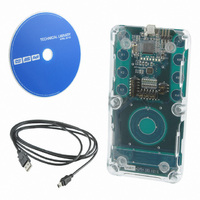ATAVRTS2080A Atmel, ATAVRTS2080A Datasheet - Page 20

ATAVRTS2080A
Manufacturer Part Number
ATAVRTS2080A
Description
KIT QTOUCH W/SW ATMEGA88
Manufacturer
Atmel
Series
QTouch™r
Specifications of ATAVRTS2080A
Sensor Type
Touch, Capacitive
Sensing Range
1 Rotor, 1 Slider, and 2 Buttons/Keys
Interface
Application Programming Interface (API)
Voltage - Supply
1.8 V ~ 5.5 V
Embedded
Yes, MCU, 8-Bit
Utilized Ic / Part
ATmega88
Tool Type
Development Kit
Cpu Core
AVR 8 / 32
Data Bus Width
8 bit
Core Architecture
AVR
Silicon Manufacturer
Atmel
Silicon Core Number
ATmega88, ATmega88A
Silicon Family Name
AVR
Kit Contents
Board, CD
Development Tool Type
Hardware / Software - Eval/Demo Board
Rohs Compliant
Yes
Lead Free Status / RoHS Status
Lead free / RoHS Compliant
Sensitivity
-
Lead Free Status / Rohs Status
Details
- Current page: 20 of 178
- Download datasheet (4Mb)
5.4.5
In designs where the sensors are close together or set for high sensitivity, multiple sensors might
report detect simultaneously if touch is near them.
intended single touch, the touch library provides the user the ability to configure a certain number
of sensors in an AKS group.
When a group of sensors are in the same AKS group, then only the first strongest sensor will
report detection. The sensor reporting detection will continue to report detection even if another
sensor’s delta becomes stronger. The sensor stays in detect until its delta falls below its detection
threshold, and then if any more sensors in the AKS group are still in detect then the strongest will
report detection. So at any given time only one sensor from each AKS group will be reported to
be in detect.
The library provides the ability to configure any sensor to be included in any one of the Adjacent
Key Suppression Groups (AKS Group).
Setting
AKS Group
5.5 Using the Sensors
5.5.1
In ATMEL QTouch library variants that use QTouch acquisition technology, adjacent sensors are
not measured at the same time. This prevents interference due to cross-talk between adjacent
channels, but at the same time some sensor configurations take longer to measure than others.
For example, if an 8-channel device is configured to support 8 keys, then the library will measure
the keys on channels 0, 2, 4, and 6 parallely, followed by keys on channels 1, 3, 5, and 7. If the
same device is configured, say, to support 4 keys, putting them either on all the odd channels or
on all the even channels means that they can all be measured simultaneously.
This means the library calls are faster, and the device can use less power. So, it is recommended
that the appropriate channel numbers are used when using less than the maximum number of
channels available for the device to ensure optimum performance. In a similar sense for faster
execution and reduced power consumption, it is also advisable to use intra-port sensor
configuration instead of inter-port sensor configuration while using 4 channels on the same port.
5.5.2
The library will not automatically perform multiple measurements on a sensor (Ex: To resolve for
instance Detect Integration or recalibration.). The user is given the option to perform the
measurement multiple times if certain conditions are met. This will enable the user to implement
the time critical code thereby making the qt_measure_sensors() a non-blocking API .The host
application has to perform multiple measurements, based on the need. The global flag
QTLIB_BURST_AGAIN indicating that multiple measurements are needed is passed to the user.
This is BIT8 of the return value from the qt_measure_sensors( ) API. The main_<devicename>.c
has the example usage to perform multiple measurements.
If QTLIB_BURST_AGAIN = 1, multiple measurements are needed to
20
Adjacent Key Suppression (AKS)
Avoiding Cross-talk
Multiple measurements
To compensate for drift
Resolve re-calibration
Resolve calibration.
Resolve detect integration.
Variable name
aks_group
Data Type
uint8_t (3 bits)
To allow applications to determine the
Unit
Enum
Min
0 (off)
8207J-AT42-02/11
Max
7
Typical
0 (off)
Related parts for ATAVRTS2080A
Image
Part Number
Description
Manufacturer
Datasheet
Request
R

Part Number:
Description:
DEV KIT FOR AVR/AVR32
Manufacturer:
Atmel
Datasheet:

Part Number:
Description:
INTERVAL AND WIPE/WASH WIPER CONTROL IC WITH DELAY
Manufacturer:
ATMEL Corporation
Datasheet:

Part Number:
Description:
Low-Voltage Voice-Switched IC for Hands-Free Operation
Manufacturer:
ATMEL Corporation
Datasheet:

Part Number:
Description:
MONOLITHIC INTEGRATED FEATUREPHONE CIRCUIT
Manufacturer:
ATMEL Corporation
Datasheet:

Part Number:
Description:
AM-FM Receiver IC U4255BM-M
Manufacturer:
ATMEL Corporation
Datasheet:

Part Number:
Description:
Monolithic Integrated Feature Phone Circuit
Manufacturer:
ATMEL Corporation
Datasheet:

Part Number:
Description:
Multistandard Video-IF and Quasi Parallel Sound Processing
Manufacturer:
ATMEL Corporation
Datasheet:

Part Number:
Description:
High-performance EE PLD
Manufacturer:
ATMEL Corporation
Datasheet:

Part Number:
Description:
8-bit Flash Microcontroller
Manufacturer:
ATMEL Corporation
Datasheet:

Part Number:
Description:
2-Wire Serial EEPROM
Manufacturer:
ATMEL Corporation
Datasheet:












